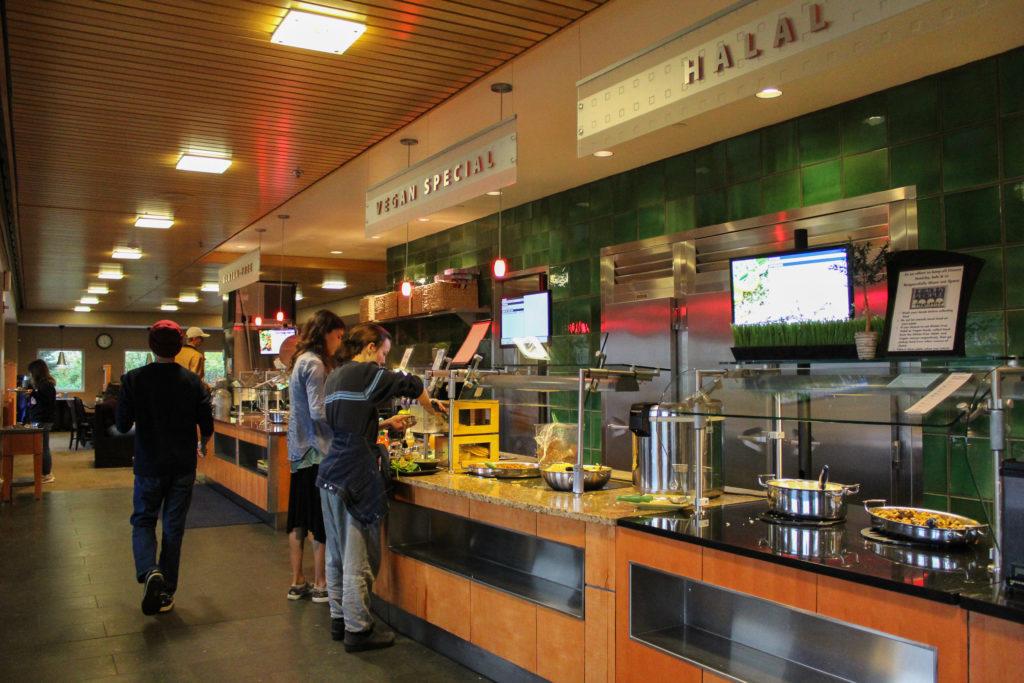Meal plan price increase raises questions about Dining Hall quality
March 12, 2023
Following a 5.5% increase in Dining Hall meal plan costs, some students are questioning whether they are getting what they pay for.
For the 2023-24 academic year, the price of the full meal plan — 20 meals per week — has risen to $8,378. According to a campus-wide email from Germaine Gross, treasurer and vice president of finance, on Feb. 21, the board of trustees and College leadership approved a 5.5% increase to comprehensive fees. The email cites inflation, surging operating costs and volatile financial markets as the primary factors leading to the increase.
For the 2022-23 academic year, the full meal plan was set at $7,940, which breaks down to $12 for breakfast, $15 for lunch and $18 for dinner. Aside from cases of severe dietary restrictions or allergies, all first-year students are required to enroll in the full meal plan for their first semester. They can choose between two options for second semester, although the prices are the same for both plans. All students must be on one of six meal plan options unless they reside in designated co-ops and campus houses or live off campus.
The S&B reached out to Gross, Britt McConnell, dietitian, and Jeanette Moser, director of dining services, for comment on this article and was redirected to Mattia Wells, a communications and marketing office spokesperson, who compiled information from the College administration.
According to Wells, the cost of the meal plan is determined as part of the College’s budget planning process. Since all elements of the comprehensive fee — tuition, fees, room and board — tend to increase equivalently, the meal plan has steadily remained roughly 10% of the College’s total cost of attendance. Meaning, as seen in the Grinnell College Common Data Set, the proportion of meal plan cost to total cost of attendance has been consistent since the data collection began in 1999.
The cost of the meal plan accounts for food, labor and overhead costs. This includes employee benefits, insurance and educational programs. Currently, dining services employs 84 full-time staff, 75 of which are service and culinary staff. Additionally, there are 14 part-time staff and 117 student staff.
Because the College runs as a not-for-profit, the College states that the goal of meal plan pricing is to enable dining services to provide high-quality options for students, not to make money. According to Julie Lascol, associate director of community-engaged learning, the city of Grinnell, as a whole, faces food accessibility challenges.
To explain why stores that offer local food are often driven out of business, Lascol said, “While the town of Grinnell is not technically a food desert, rural areas, especially in cold climates, face a variety of challenges when it comes to access to food. This has only worsened with stores like Walmart coming to town who can use economies of scale and lower wages to keep their prices down. ”
Lascol continued, “Our dependence on cheaper food and the cascade effect on employment, health and the environment is real.” Due to the short growing season, the availability of fresh, local food is limited to late April through October.
When the College is unable to rely on local food, it becomes expensive to provide high-quality, flavorful food with a low carbon footprint. “Food prices in general have increased 17% in the past 18 months,” Wells wrote in an email to the S&B. “This is more than the meal plan prices have increased over several years.”
Yet, some students feel that regardless of challenges in the food supply chain, the College needs to provide better options if they are going to charge $8,378
Will Chapin `24, who is 100% gluten-free due to celiac disease, said that the College is not following through on its commitment to dietary accommodations and consistent access to healthy food.
“I’ve always felt like I haven’t gotten even remotely what I’ve paid for in regards to the cost of the meal plan and the quality of the meals,” said Chapin. “If they literally bought, like, $12 frozen meals from Walmart, it would already be better. It doesn’t feel fair at all with how much I have to pay to get really subpar access.”
Despite the consistent struggle to create adequate meals, Chapin said he believes the options for accommodations are unclear and inefficient. “At the start of last fall, I was on the full meal plan, and it felt so much like I was starving that I put in requests with ResLife and disability resources to get off of the meal plan,” Chapin said. “That meant that I had to move where I was living. So I moved out of Langan and into Food House just because I couldn’t eat the food provided in the Dining Hall.”
According to Wells, McConnell is available to meet with students about medication or personal dietary restriction with or without a referral from disability resources. “If the Dining Hall doesn’t have suitable options, specific items can be secured for the student. An accommodation is needed for specialty items to be prepared and purchased on an ongoing basis,” wrote Wells.
Chapin said he believes that the primary issue is not an inability to create healthy, safe options for students with dietary restriction — rather, it is the inability to consistently have them available. “If they actually put out the things that they tell us are always going to be in the gluten free sections,” Chapin said, “it still probably wouldn’t be the best service, but it would at least be an improvement.”
Chapin says that the only reason he continues to be on the 65 meals per semester meal plan is for convenience. “I know myself well enough to not expect myself to cook for every meal. I sort of have the Dining Hall as a safety net.”
Lascol said that although her information is purely anecdotal, she has “met students for whom what they were asked to pay in terms of room and board presented challenges, especially if they were working and sending money home to family.” However, Lascol said that she has been impressed by the College’s financial aid response to these circumstances.
Mara Feirer `25, who has a severe gluten intolerance and chooses to avoid beef and pork, also said that there are days when she feels like there are no good options. “There are often days at the Dining Hall where the plat du jour, gluten free, vegan and stir fry stations are all inaccessible to me,” said Feirer. “For example, the gluten-free entree will contain beef, and the vegan entree will contain gluten. I can get gluten-free pasta from the sauté station, but that requires a wait time, and the salad bar is a difficult place to avoid cross-contamination.”
In response to the meal plan rising over $8,000 next year, Feirer said that any cost would be unreasonable considering her current experience. “I can’t really rely on easily getting food I can eat, so regardless of price I don’t feel like the meal plan satisfies my needs.”
Feirer also said that part of the problem is that as a second-year, she is required to live on campus and have a meal plan. If she had easier access to a clean and empty kitchen, Feirer said that she would not need to rely on the Dining Hall nearly as much. Additionally, Feirer said that she thinks Spencer Grill should expand their options and introduce more gluten-free hot food items.
Unlike some comparable institutions that contract with outside companies like Bon Appétit for dining services, Grinnell Dining Services is self-operated. According to Wells, this means that approximately 90% of the food is made from scratch, and the majority of the menus and recipes are designed by certified chefs. The College claims to “keep its costs in line with its peers.”
While it is difficult to accurately compare institutions due to the impact of location on meal plan pricing, two similarly rural peer institutions — Kenyon College and Carleton College — currently have full board set at $8,010 and $7,551, respectively.
In the fall 2022 semester, Dining Services served 239,992 meals to students on meal plans 1, 2, 3 and 4. Throughout that process, Wells said that changes to meals and recipes occur frequently and encouraged student feedback. “Dining Services continually monitors the comment board in the Marketplace and takes it very seriously. We have implemented changes based on comments from the board. Student input is always welcome.”



















































